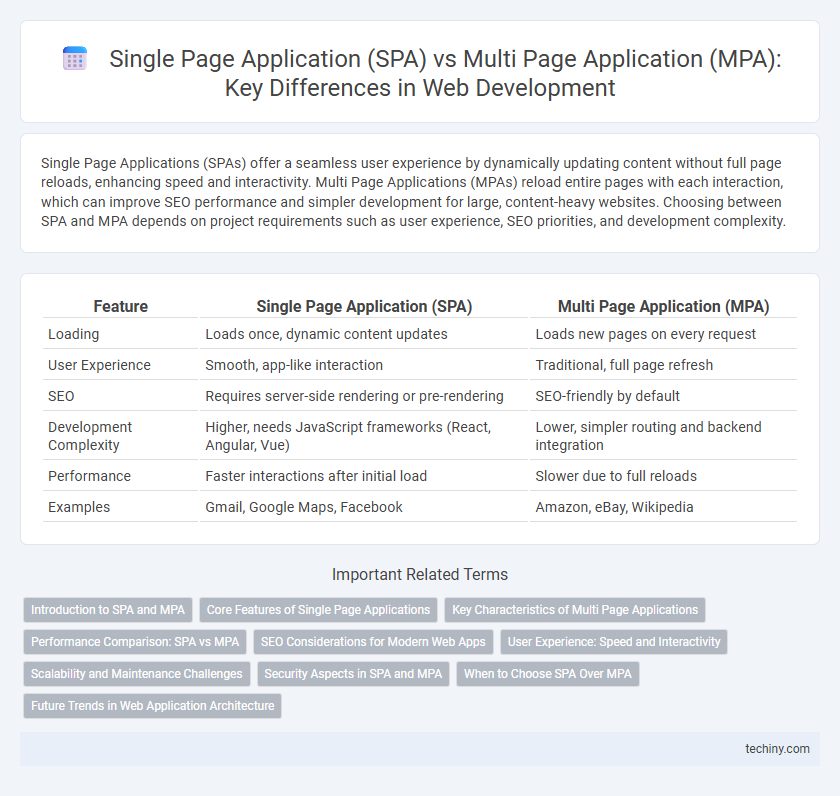Single Page Applications (SPAs) offer a seamless user experience by dynamically updating content without full page reloads, enhancing speed and interactivity. Multi Page Applications (MPAs) reload entire pages with each interaction, which can improve SEO performance and simpler development for large, content-heavy websites. Choosing between SPA and MPA depends on project requirements such as user experience, SEO priorities, and development complexity.
Table of Comparison
| Feature | Single Page Application (SPA) | Multi Page Application (MPA) |
|---|---|---|
| Loading | Loads once, dynamic content updates | Loads new pages on every request |
| User Experience | Smooth, app-like interaction | Traditional, full page refresh |
| SEO | Requires server-side rendering or pre-rendering | SEO-friendly by default |
| Development Complexity | Higher, needs JavaScript frameworks (React, Angular, Vue) | Lower, simpler routing and backend integration |
| Performance | Faster interactions after initial load | Slower due to full reloads |
| Examples | Gmail, Google Maps, Facebook | Amazon, eBay, Wikipedia |
Introduction to SPA and MPA
Single Page Applications (SPA) load a single HTML page and dynamically update content as the user interacts, offering faster navigation and a more fluid user experience. Multi Page Applications (MPA) consist of multiple interconnected pages, each requiring a full reload, which can impact performance but may be better suited for large, content-heavy websites. SPA frameworks like React, Angular, and Vue.js optimize client-side rendering, while MPAs often leverage traditional server-side rendering for SEO and initial load advantages.
Core Features of Single Page Applications
Single Page Applications (SPA) load a single HTML page and dynamically update content without full page reloads, enhancing user experience through faster interactions. Core features include client-side routing, asynchronous data fetching via AJAX or Fetch API, and state management using frameworks like React, Angular, or Vue.js. SPAs improve performance by reducing server load and enable smoother transitions with tools such as virtual DOM and component-based architecture.
Key Characteristics of Multi Page Applications
Multi Page Applications (MPAs) feature multiple distinct pages, each requiring a full page reload when navigating, which enhances SEO performance and allows for fine-grained control over individual page content. MPAs typically use server-side rendering, improving initial load times and making them suitable for large-scale websites or applications with diverse and complex content structures. This architecture supports better scalability and easier integration with traditional backend systems compared to Single Page Applications (SPAs).
Performance Comparison: SPA vs MPA
Single Page Applications (SPAs) offer faster initial load times by dynamically updating content without full page refreshes, enhancing user experience with smoother interactions. Multi Page Applications (MPAs) typically have slower navigation between pages due to full reloads, but they benefit from better SEO and easier scalability for complex sites. Performance depends on factors like application size and caching strategies, with SPAs excelling in reduced server load and MPAs favored for simpler resource management.
SEO Considerations for Modern Web Apps
Single Page Applications (SPAs) often face SEO challenges due to their reliance on client-side rendering, which can hinder search engine crawlers from indexing dynamic content effectively. Multi Page Applications (MPAs) provide better SEO performance by serving static HTML pages for each route, enabling easier content discovery and faster indexing. Implementing server-side rendering (SSR) or pre-rendering techniques in SPAs can bridge the SEO gap, ensuring modern web apps achieve optimal visibility on search engines.
User Experience: Speed and Interactivity
Single Page Applications (SPAs) enhance user experience by delivering faster load times and seamless interactivity through dynamic content updates without full page reloads. In contrast, Multi Page Applications (MPAs) often result in slower navigation as each user action triggers a complete page refresh, impacting responsiveness. The smooth transitions and reduced server requests in SPAs contribute to improved speed and more engaging interactions compared to traditional MPA structures.
Scalability and Maintenance Challenges
Single Page Applications (SPAs) offer streamlined user experiences by loading a single HTML page dynamically but face significant scalability challenges as the application grows due to complex state management and heavy client-side rendering. Multi Page Applications (MPAs) provide better scalability through modular backend architecture, easing maintenance by isolating functionalities into separate pages, which simplifies debugging and updates. However, MPAs may suffer from slower user experiences and increased server load, complicating overall performance optimization in large-scale deployments.
Security Aspects in SPA and MPA
Single Page Applications (SPAs) often face increased security challenges such as Cross-Site Scripting (XSS) and token-based authentication vulnerabilities due to heavy reliance on client-side scripts and APIs. Multi Page Applications (MPAs) benefit from server-side rendering, offering better protection against XSS and Cross-Site Request Forgery (CSRF) attacks by isolating page requests and sessions. Implementing Content Security Policy (CSP) and secure cookie handling is essential in both SPA and MPA architectures to mitigate common security threats effectively.
When to Choose SPA Over MPA
Single Page Applications (SPAs) are ideal when creating dynamic, fast-loading user experiences requiring real-time updates and seamless navigation without full page reloads. They excel in applications like social networks, dashboards, and online collaboration tools where continuous interaction and quick content changes are critical. Choosing SPA over Multi Page Application (MPA) helps reduce server load and enhances client-side rendering efficiency, improving performance for users on modern browsers.
Future Trends in Web Application Architecture
Single Page Applications (SPAs) are evolving with enhanced JavaScript frameworks like React, Angular, and Vue.js, enabling faster load times and improved user experiences by dynamically updating content without full page reloads. Multi Page Applications (MPAs) maintain relevance by supporting complex SEO strategies and better compatibility with legacy systems, often leveraging server-side rendering and microservices architectures. Future trends indicate a convergence of SPA and MPA benefits through hybrid models such as Progressive Web Apps (PWAs) and server-driven UI frameworks, optimizing performance, scalability, and maintainability in modern web development.
Single Page Application (SPA) vs Multi Page Application (MPA) Infographic

 techiny.com
techiny.com